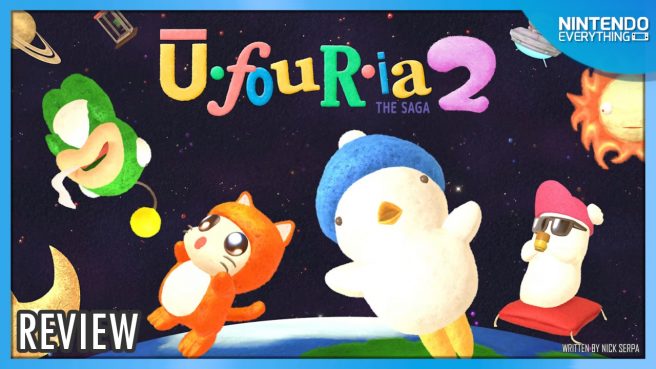[Review] Ufouria: The Saga 2
System: Switch
Release date: March 1, 2024
Developer: Sunsoft
Publisher: Red Art Games
Back in 1991, video game developer Sunsoft – perhaps best-known these days for its Blaster Master series – was trying to get a new franchise off the ground, in part to help cement a new mascot for the company. Ufouria: The Saga was the result – a quirky 2D platformer whose main gimmick was its ability for players to swap between four different characters. While the game did well enough to spawn a series of puzzle games featuring the same oddball cast and charming presentation, the original title been almost entirely unavailable for western players outside of a now-inaccessible Virtual Console rerelease and a limited run in Europe. That’s why it’s such a delightful surprise that now, over thirty years later, Sunsoft has released a sequel – and fortunately, an excellent one. Ufouria: The Saga 2 not only tightly modernizes the satisfying gameplay of the original, but imbues its world and characters with a sense of whimsy and humor that had me smiling from start to finish.
At a surface level, Ufouria: The Saga 2 gives the impression that it’s going to deliver a somewhat straightforward 2D platforming experience – albeit one with an adorable craft-material aesthetic that feels inspired by the likes of Yoshi’s Wooly World. That being my expectation, I was surprised to find that the game pulls elements from from both exploration-platformers and rougelike sidescrollers into a uniquely structured package. While Ufouria 2 is brief and almost comically easy, it’s also a surprisingly dense game with quite a bit for completionists, and I found myself compelled to experience as much of it as possible in my six-hour initial playthrough.
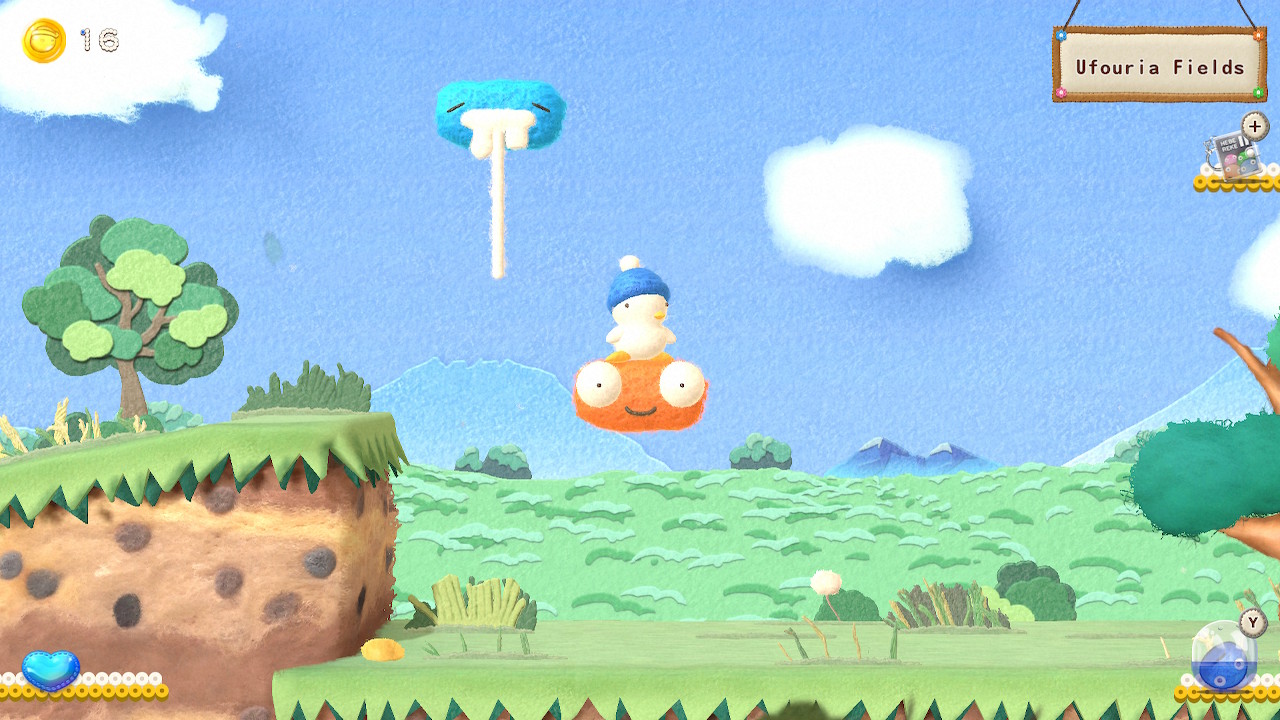
Ufouria 2’s map is split into different regions, all quite standard fare – your grassy valley zone, your volcano area, your icy underground caverns, and so on. The world is technically open and lightly interconnected – nothing stops the player from trying to explore to the left when the objective is to the right – but what’s interesting is that Ufouria 2 plays more like a run-based game than you would expect. In lieu of any sort of sort of labyrinthine structure, each biome feels more akin to a self-contained stage, often with a boss fight at the end. The twist is that every time the player accomplishes an objective along the main story path, they’re then flown back to the center of the map by the helpful bird Bobodori, at which point upgrades can be purchased before setting back out to explore deeper.
Upon returning to the same region again, the layout of the area will often change; I’d estimate each region has somewhere in the ballpark of between four and eight handcrafted designs, with enemies and collectibles placed differently in each one. The benefit of this format is that it helps each location feel fresh when revisiting it later, and this is further amplified by the the fact that as players progress through the game, new abilities will let them grab hard-to-reach collectibles they couldn’t access the first time around. While I wish the stages were bigger and had some tougher platforming segments, I ultimately really enjoyed this structure, and always looked forward to seeing what I could now do each time I backtracked to a familiar zone.
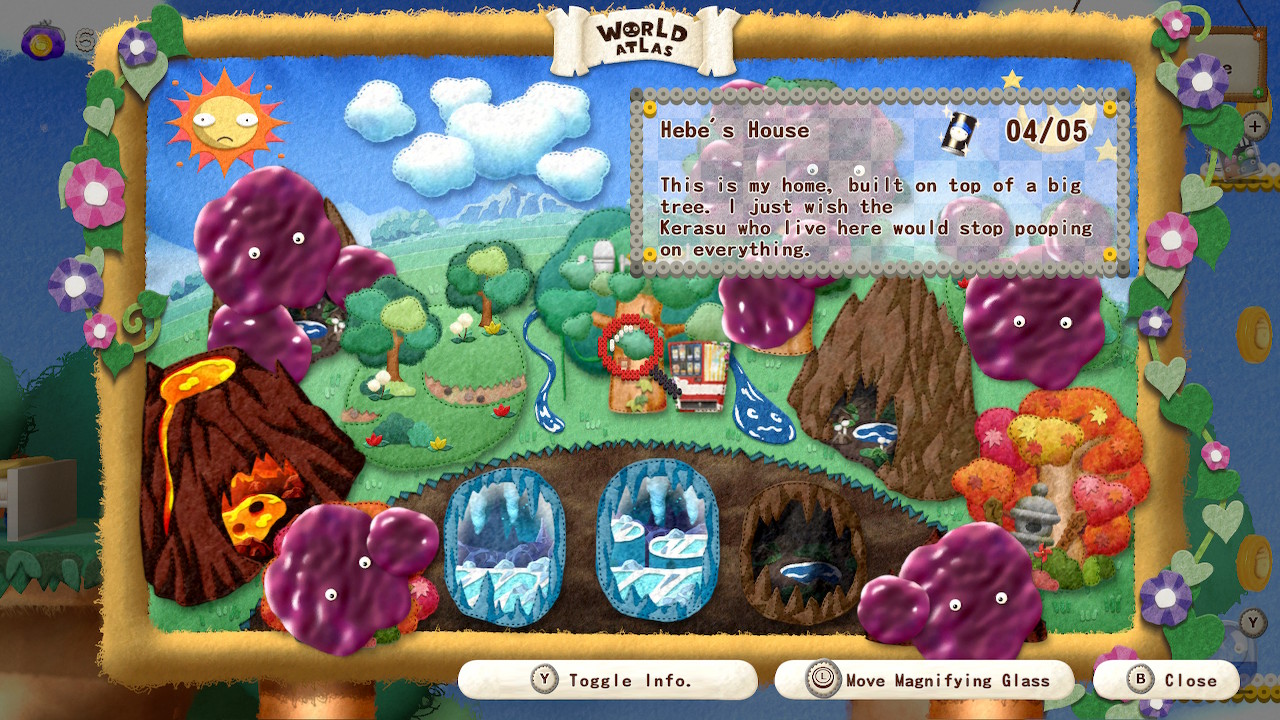
The real stars of of the show are Ufouria 2’s four playable characters who return from the first game with a substantial glow-up this time around. There’s the albino penguin named Mr. Hebe, a cat-girl named O-Chan, a ghost wearing shades named Sukezaemon, and an anglerfish, named…. uh, Jennifer (note: if you played the original Ufouria, some of the characters may have had different names depending on which region’s version of the game you played). They’re a motley crew and close friends, and have lived peacefully in the land of Ufouria for presumably decades at this point. Well, until the recent arrival of returning villain Utsujin, who is polluting the planet with gelatinous purple lifeforms called Bumyons that can attach themselves to living creatures. And so, predictably, Mr. Hebe and company set forth to put a stop to it all.
At the start of Ufouria 2, our flippered friend Mr. Hebe is the only playable character – in fact, a good chunk of the first half of the game involves traveling to the different corners of the map to recruit his friends. Eventually, with the push of a button, the player can swap between the four characters at will, accompanied by a delightful high-five animation as they change places. There’s good reason to do so, as some characters are better-suited to different situations than others. For example: Jennifer is the only one that can dive under the water to access entire portions of the map; O-Chan is a fast swimmer and won’t slip on icy surfaces, and Sukezaemon has a floatier jump that lets him glide across large distances. They’re all a delight to play as, and the game really wants you to swap between them often – although frequent dialogue popups in which characters ask when it will be “their turn” to take the lead can definitely get a little annoying over time.

The world is populated with some truly strange and surreal foes, from a human mouth that uses its tongue to drag itself across the ground, to a crawling baby in a diaper, to chonky birds that poop all over the place. Interesting designs aside, they’re all dispatched the same way – by butt-stomping them with the ZR button in mid-air. The only wrinkle is if an enemy has been corrupted by Bumyons first – in other word, if it has purple goop on its face – you’ll first need to stun it before you can safely “use your butt” to defeat it, as the game’s tutorials cheekily explain it. You do this by throwing your own blobs of goop – called Popoons – at foes first. It adds a small wrinkle to the process of defeating an enemy, but aiming isn’t difficult, and the reality is most foes can be avoided entirely simply by jumping over them, with no real downside to doing so other than missing out on some coins.
Even boss battles are shockingly easy, to the point where they feel inconsequential. Not only do boss enemies almost all look identical, the only real threat they pose to you is if they touch the player character – they never launch projectiles, perform AOE attacks, or really do anything that would require the player to change their strategy. Sometimes they’ll move a bit faster, or fly in the air a little, but that’s it. I still had fun with them, but that’s mostly because I enjoyed the tight core gameplay enough that the 30 seconds it took to dispatch a boss didn’t really move the needle in either direction for me.
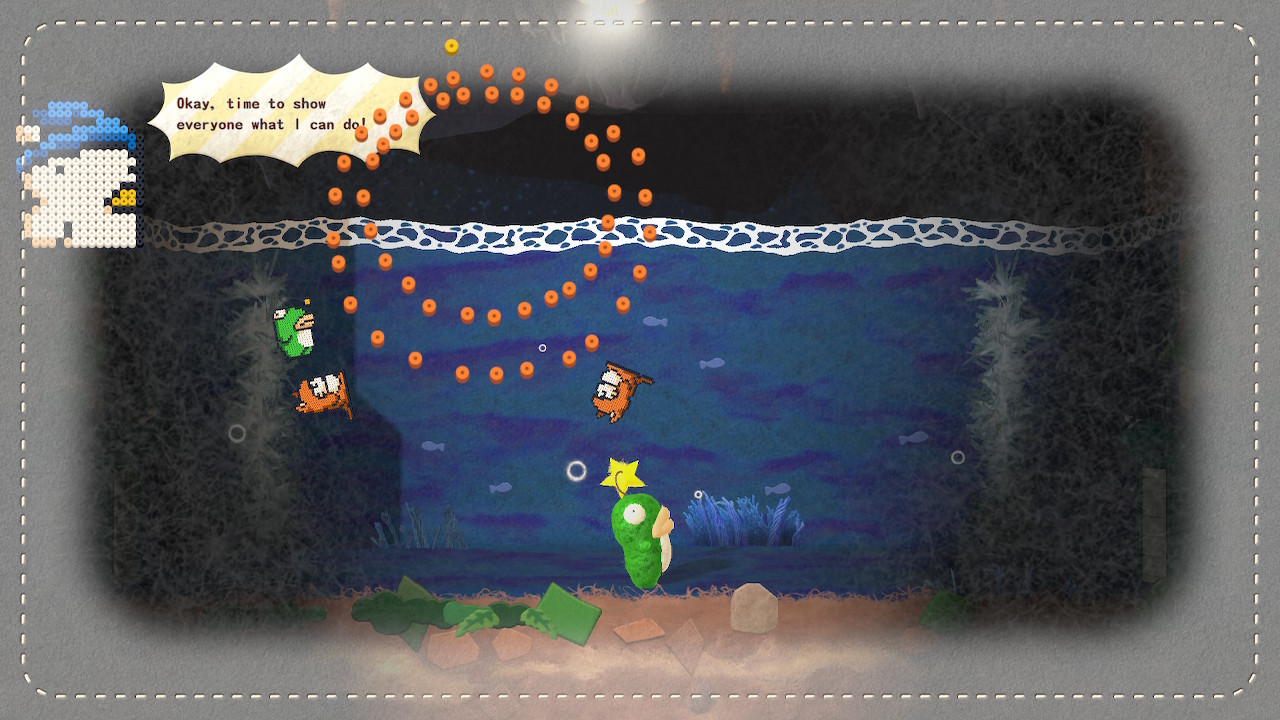
For players looking for some optional challenge, there are some solutions for that. Ufouria 2 has some challenge rooms that task players with completing specific objectives, like clearing all foes in a certain time limit without taking any damage. A few of these were a little tricky, but never to the point where I got frustrated. Revisiting an area you’ve been to before also gives the player a chance to meet similar criteria, like getting through a stage in a tight time limit. There’s also a harder difficulty mode, but it has to be unlocked during the course of a playthrough, at which point you’ll likely be already almost complete with the game – I would have preferred to have the option available from the onset.
Upgrades and new abilities are purchased from a vending machine in front of Mr. Hebe’s house. Most of the important ones – like crouching, and carrying more than one Popoon at a time – are affordable and can be unlocked within an hour of play. You’ll definitely want to invest in an ability that lets characters see through walls to find hidden areas, and there are other useful ones that let inactive characters in your party give you extra coins and health at random intervals. Beyond that, most of what’s here just exists to add quality-of-life features to your playthrough. For example, there’s a compass you can buy earlier on that tells you how many Utsu-cans – the game’s primary collectible, that look like an energy drink – are scattered in each region, which is great for completionists. Additional vending machines are scattered across the world that only sell healing items, so its easy to avoid dying and getting sent back to Hebe’s house as long as you carry some extra coins with you.
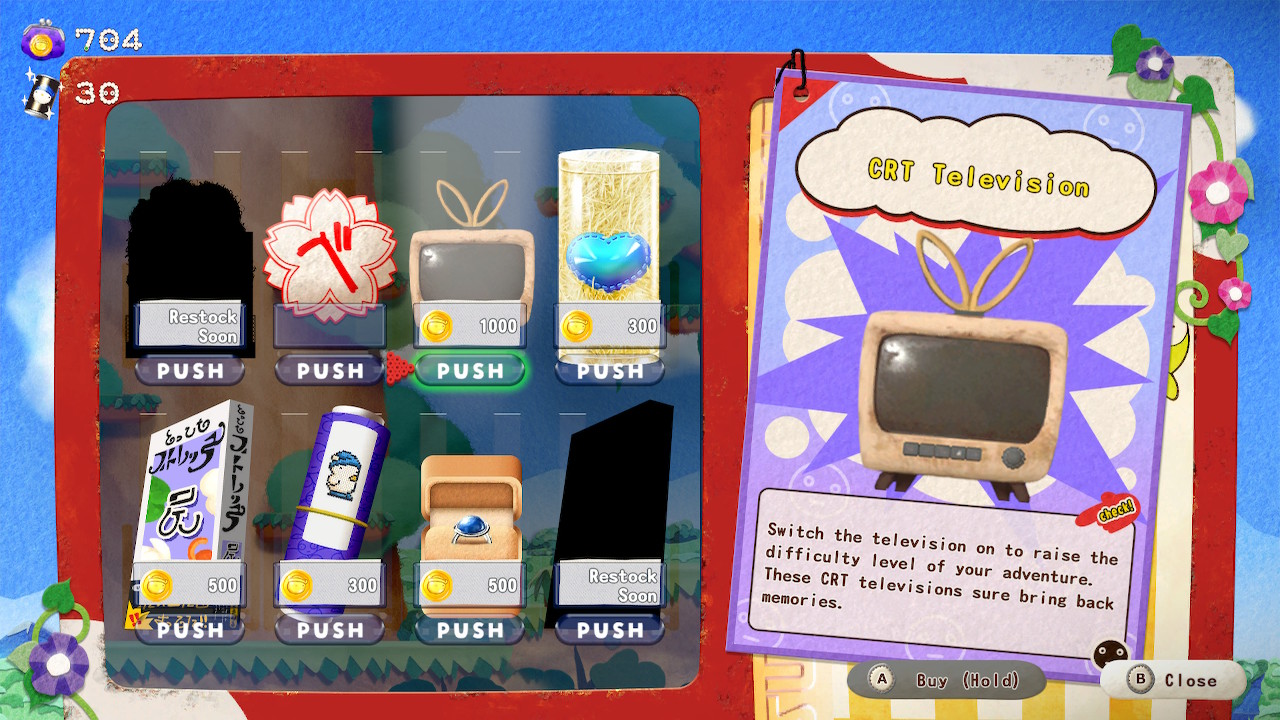
While the gameplay loop may not be challenging, what matters most is that it’s fun, and I think Ufouria 2’s brief runtime helps keep it from overstaying its welcome. That being said, the thing that initially caught my attention about this release was its stunning artistic direction, and it’s one of the game’s strongest elements. Ufouria 2 looks like an arts and crafts project that’s come to life. The world looks like it was built of patches of fabric and mounds of clay, and characters look almost like stuffed animals that have been crocheted and stitched. Look closely at the details and you’ll even notice the stray strands of string sticking out from their stuffed forms. It’s a huge shift in aesthetic compared to the original game’s 8-bit graphics, and if you had told me that Good-Feel had made this game, I’d probably believe you. Everything looks crisp and textured in both docked and handheld mode, and performance was excellent, too.
There’s astonishing attention to detail in every other visual element of the game, too. Dialogue boxes and character portraits look like they’re made from Perler beads, and the shopping screen juxtaposes 3D-modeled objects against pop-art backgrounds. Even the map screen looks like it was modeled after the sort of backdrops you might see in a children’s puppet show, with felt elements haphazardly Velcroed against a fabric backdrop. In motion, it all looks even better. Characters are expressive, all with their own unique animations, some of which are low-key hilarious – like how Jennifer just sits on the ground and slides when “crawling”. There’s a delightful bounciness to the way everything moves, and it’s all made funnier by the delightfully blunt writing, especially when it unexpectedly breaks the fourth wall.
The music is another strong point in Ufouria 2’s favor. It evokes the chiptune soundtrack of the original game, but its slightly off-key vocal harmonies add to surreal-yet-cute atmosphere that’s emphasized by the art style and animation. Droopy synthesized brass notes and a boppy rhythm will undoubtedly leave some of the game’s melodies stuck in your head long after the fact. A few more tracks here and there would have been beneficial, but because of the short runtime, I wasn’t as bothered by the repeating songs as I otherwise might have been.
The Verdict

Ufouria: The Saga 2 is a brief and breezy platformer that’s bursting at the seams with charm and creativity. While its moment-to-moment running and jumping may be simple, it’s also tight and responsive, and the clever structure of the game’s run-based exploration results in satisfying progression that just gets better as players unlock more characters and abilities. While some may see the low overall difficulty as a downside, it also gives more room for the top-notch visuals to shine. The writing is often genuinely chuckle-worthy, and the music helps elevate the quirky, strange themes of the game to a higher level. As a rare sequel to an over thirty-year-old NES game, Ufouria: The Saga 2 excels, and leaves me genuinely excited to see what else Sunsoft can do down the road with these characters and this world. Fans of 2D platformers and Nintendo-like experiences owe it to themselves to give this game a look.
Ufouria: The Saga 2 copy provided by the publisher for the purposes of this review.
